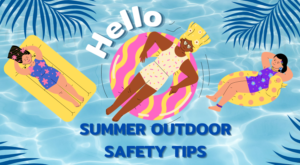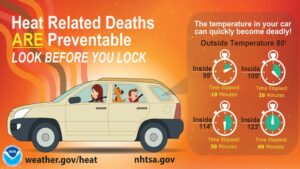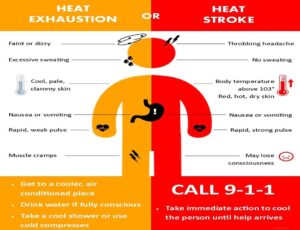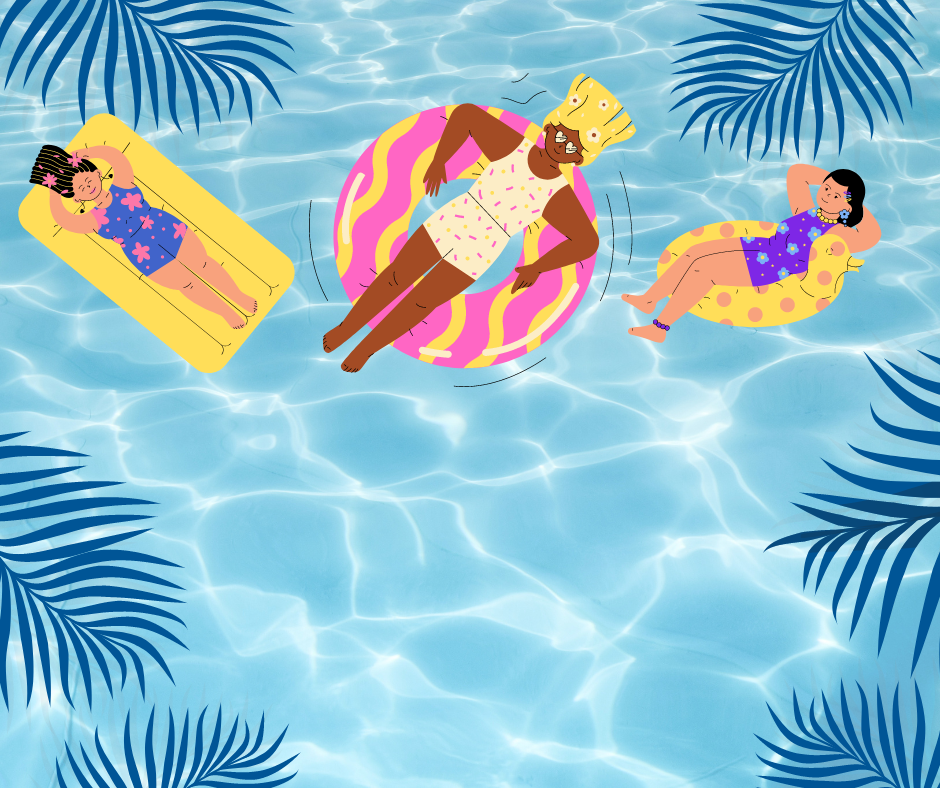
As the summer sun and temperatures rise, so does the amount of time many people spend outdoors and engage in different routines. Take a moment to remind yourself of the practical tips in the articles below, each of which focuses on a different element of safety to help summer fun reign supreme.
Family Builders’ article entitled “Summer safety tips to help prevent child abuse” can be found using the link here.
How to protect yourself from the sun….
- Some people are more prone to sunburns:
- People with fair skin are at higher risk.
- But ANYONE can get burned.
- Even without a burn, sun exposure raises skin cancer risk:
- The sun can cause cellule damage that can lead to skin cancer.
- You can burn on an overcast day:
- Be careful when the sun is not shining.
- Light pink is still bad:
- Every burn is a sign of injury to your skin.
- Cover up:
- Clothing can provide a barrier against the sun’s (UV) rays.
- The more covered skin, the better it is.
- Make sure you wear a hat that shades your eyes, face, and neck.
- Wear sunglasses that have (UV) rating.
- Stay in the shade.
- Stay in the shade from 10 a.m.-4 p.m.
- Walk on the shady side of the street.
- Use sunscreen:
- The SPF tells you how long the sun’s rays will take to redden your skin.
- Make sure that you look for an SPF that is 30 or higher.
- Make sure that you reapply the sunscreen every two hours.
- When you get out of the pool make sure you reapply.
- Do not use tanning beds.
- Shield the little ones:
- It is best to keep kids out of the sun for the first six months of life.
- Make sure you cover all the kid’s skin.
- Make sure they have a hat and sunglasses.
- For toddlers, cover up and apply sunscreen.
- Skin self-exam:
- Do your self-skin exams.
Types Of Sunburns…
- First-degree sunburn (Superficial Thickness burns):
- Damage to your skin’s outer layer.
- This usually heals on its own in a few days to a week.
- Second-degree sunburn (Partial Thickness burns):
- Damage to the inner layer of your skin (dermis).
- This may cause blistering.
- It can take weeks to heal and may need medical treatment.
- Third-degree sunburn (Full Thickness burns):
- Severely damages all layers of your skin.
- Including the fat layer beneath the skin.
- May destroy nerve endings.
- Requires emergency treatment.
How To Treat Sunburns…
- Take frequent cool baths or showers to help relieve the pain:
- As soon as you get out of the shower, pat yourself dry, but leave a little water on your skin.
- Apply moisturizer to help trap the water in your skin.
- Use a moisturizer that contains aloe vera or soy to help soothe sunburned skin:
- Call your healthcare provider or pharmacist and ask what the best type of moisturizer is.
- Consider taking aspirin or ibuprofen to help reduce swelling, redness, and discomfort:
- Call your healthcare provider before you take over-the-counter medication for your sunburn.
- Drink extra water:
- Drink extra water to help prevent dehydration.
- If your skin blisters, allow the blisters to heal:
- DO NOT pop the blisters, they will help the skin heal.
- You may need to call your healthcare provider if they become infected.
- Take extra care to protect sunburned skin while it heals:
- Wear clothing that covers your skin when outdoors.
- Call your healthcare provider if you have any concerns about your sunburn.
Leaves in three let them be….
- Poison Ivy:
- Can grow as a vine or small shrub trailing along the ground or climbing on low plants, trees, and poles.
- Each leaf has three glossy leaflets, with smooth or toothed edges. Leaves are reddish in spring, green in summer, and yellow, orange, or red in fall.
- The vine to which the leaves are attached is often “hairy” in appearance.
- May have greenish-white flowers and whitish-yellow berries.
- Poison Oak:
- Fuzzy green leaves in clusters of three are lobed or deeply toothed with rounded tips. May have yellow-white berries.
- Poison Sumac:
- Grows as a tall shrub or small tree in bogs or swamps.
- Each leaf has clusters of seven to 13 smooth-edged leaflets. Leaves are orange in spring, green in summer, and yellow, orange, or red in fall. May have yellow-greenish flowers and whitish-green fruits hang in loose clusters.
- First comes the itching, then a red rash, and then blisters.
- These symptoms of poison ivy, poison oak, and poison sumac can emerge any time from a few hours to several days after exposure to the plant oil found in the sap of these poisonous plants.
- The culprit: the urushiol oil.
- Poison ivy and other poison plant rashes can’t be spread from person to person.
- It is possible to pick up the rash from plant oil that may have stuck to clothing, pets, garden tools, and other items that have come into contact with these plants.
- The plant oil lingers (sometimes for years) on virtually any surface until it’s washed off with water or rubbing alcohol.
Tips For Treatment…
- DON’T scratch the blisters.
- Using wet compresses or soaking in cool water.
- Ask your pharmacist what the best over-the-counter medication is.
Recreational Water Illnesses…
- When a person who has diarrhea gets in the water, that tiny amount of fecal matter on their body can wash into the water and contaminate the water.
- If someone else swallows the contaminated water, they may become sick.
- If the chemicals used to kill germs such as chlorine or bromine in pools, hot tubs and water playground are not kept at the right level, these germs can make swimmers sick.
What You Can Do to Prevent Recreational Water Illnesses…
- Shower before you get in the water.
- Keep poop out of the water.
- Do not poop or pee in the water.
- Change diapers away from the water’s edge.
- If you are sick or your child is sick, stay out of the water.
- Need to stay out of the water for 2 weeks after you have had diarrhea.
- Keep water out of your mouth when you swim.
- Make sure you take a shower when you have finished swimming.
Prevent Mosquitoes Bites…
- Use insect repellent.
- Use EPA registered insect repellents:
- DEET
- Picaridin
- Oil of Lemon Eucalyptus (OLE) – Do not use on children under the age of 3.
- Para-menthane-diol (PMD) – Do not use on children under the age of 3.
- Do not spray repellent on the skin under clothing.
- If you are using sunscreen, apply the sunscreen first then the repellent.
- Babies and children:
- Clothing that covers the arms and legs.
- Follow labels in insect repellents.
- Do not apply insect repellents to the child’s hands, eyes, mouth, cutes of irritated skin.
- Spay repellent on adult’s hand then apply to the child’s face.
- Use EPA registered insect repellents:
Summer Food Safety…
- Keep cold food cold:
- Place cold food in a cooler with ice or frozen gel packs.
- Cold food should be stored at 40 °F or below to prevent bacterial growth.
- Meat, poultry, and seafood may be packed while still frozen so that they stay colder longer.
Organize cooler contents:
- Consider packing beverages in one cooler and perishable foods in another.
- That way, as picnickers open and reopen the beverage cooler to replenish their drinks, the perishable foods won’t be exposed to warm outdoor air temperatures.
- Keep coolers closed:
- Once at the picnic site, limit the number of times the cooler is opened as much as you can.
- Don’t cross-contaminate:
- Be sure to keep raw meat, poultry, and seafood securely wrapped.
- This keeps their juices from contaminating prepared/cooked foods or foods that will be eaten raw, such as fruits and vegetables.
- Clean your produce:
- Rinse fresh fruits and vegetables under running tap water before packing them in the cooler.
- Marinate safely:
- Marinate foods in the refrigerator — never on the kitchen counter or outdoors.
- Don’t reuse marinade.
- Cook food thoroughly:
- Have your food thermometer ready.
- Always use it to be sure your food is cooked thoroughly.
- Keep “ready” food hot:
- Grilled food can be kept hot until served by moving it to the side of the grill rack, just away from the coals.
Heat related illness…


Sources:
- National Weather Service
- Centers For Disease and Control
- Environmental Protection Agency
- Food and Drug Administration
- Indiana Food Code
— Kawana Howell Rogers, BS, PCAIN Prevention Council Coordinator

